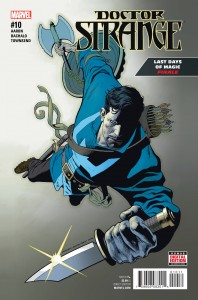 Doctor Strange #10 — Writer: Jason Aaron; Pencils: Chris Bachalo; Inks: Six Guys; Colors: Chris Bachalo with Rain Beredo
Doctor Strange #10 — Writer: Jason Aaron; Pencils: Chris Bachalo; Inks: Six Guys; Colors: Chris Bachalo with Rain Beredo
Punisher #4 — Writer: Becky Cloonan; Art: Steve Dillon; Colors: Frank Martin
Moon Knight #5 — Writer: Jeff Lemire; Art: Greg Smallwood, Wilfredo Torres, Francesco Francavilla and James Stokoe; Colors: Jordie Bellaire, Michael Garland, Francavilla and Stokoe
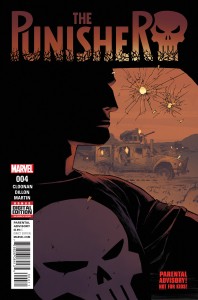 Invincible Iron Man #12 — Writer: Brian Michael Bendis; Art: Mike Deodato; Colors: Frank Martin
Invincible Iron Man #12 — Writer: Brian Michael Bendis; Art: Mike Deodato; Colors: Frank Martin
Daredevil Annual #1 — Writer: Charles Soule; Art: Vanessa R. Del Ray; Colors: Mat Lopes
Marvel Tsum Tsum #1 (of 4)– Writer: Jacob Chabot; Pencils: David Baldeon; Inks: Terry Pallott; Colors: Jim Campbell
Let’s start the week with a half-dozen Marvel titles, most of them relaunches that have settled into successful grooves. 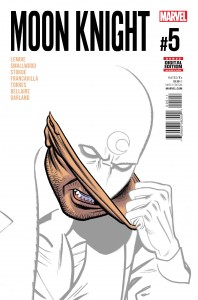 Doctor Strange, maybe the best of them, offers a big-fight-scene conclusion to its “Death of Magic” arc: I like Bachalo’s art, grounded and unearthly in equal measure, something like the ’80s Doc artist Michael Golden; I also like Aaron’s big-concept, high-stakes plots, and the idea that magic from here on out will be hard to use, requiring strategy and sacrifice, instead of two guys throwing force bolts at one another. Best of all, this story is accessible to new fans of the upcoming movie, while throwing in enough callbacks and continuity links to make the older ones happy, too. Punisher has found a similar comfort level, as Steve Dillon’s art makes a welcome return, with his repertoire of gangsters and cops
Doctor Strange, maybe the best of them, offers a big-fight-scene conclusion to its “Death of Magic” arc: I like Bachalo’s art, grounded and unearthly in equal measure, something like the ’80s Doc artist Michael Golden; I also like Aaron’s big-concept, high-stakes plots, and the idea that magic from here on out will be hard to use, requiring strategy and sacrifice, instead of two guys throwing force bolts at one another. Best of all, this story is accessible to new fans of the upcoming movie, while throwing in enough callbacks and continuity links to make the older ones happy, too. Punisher has found a similar comfort level, as Steve Dillon’s art makes a welcome return, with his repertoire of gangsters and cops 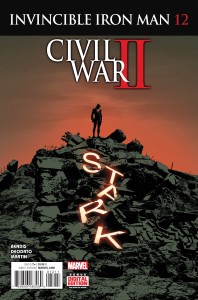 and hard-nosed government agents, all stalking, or being stalked by, the title character. Dillon’s best previous Punisher work was with writer Garth Ennis, and Becky Cloonan’s good at matching his combination of sociopaths, satire, smart action-movie sequences and casual brutality; this is another book that should satisfy both longtime readers and new TV-driven ones. Moon Knight has evolved into an Inception-like tour of the main character’s mind, with a nesting-puzzle plot that means we can’t be sure what’s real and what’s hallucination; different aspects of his multiple personalities get different guest artists, too, so we have James Stokoe contributing a jazzy, frightening werewolves-on-the-moon three-page sequence, Francisco Francavilla lending his noir chops to a scene with another alter ego, the cab-
and hard-nosed government agents, all stalking, or being stalked by, the title character. Dillon’s best previous Punisher work was with writer Garth Ennis, and Becky Cloonan’s good at matching his combination of sociopaths, satire, smart action-movie sequences and casual brutality; this is another book that should satisfy both longtime readers and new TV-driven ones. Moon Knight has evolved into an Inception-like tour of the main character’s mind, with a nesting-puzzle plot that means we can’t be sure what’s real and what’s hallucination; different aspects of his multiple personalities get different guest artists, too, so we have James Stokoe contributing a jazzy, frightening werewolves-on-the-moon three-page sequence, Francisco Francavilla lending his noir chops to a scene with another alter ego, the cab-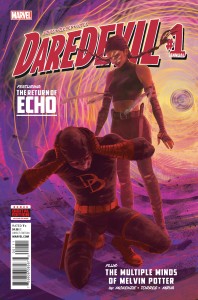 driver Jake Lockley, and so on. Jeff Lemire’s just the writer to juggle all those complicated psychological plates in the air with style and skill, and the diverse, interesting art should keep everyone coming back. Invincible Iron Man is the one Civil War II tie-in I bought, and with Bendis writing both titles, it’s practically a chapter of the main event. Tony Stark looks to be leaving the book for a while, maybe a year or more, and a couple of different characters will be jockeying for the title mantle instead; this issue sets up most of the whys and whos and hows, so it’s an essential bridge into the new status quo. Daredevil Annual has the return of the character Echo (not exactly a spoiler, since right there on the cover it says “The Return of ECHO”), with Del Ray contributing some great interior art, especially on how DD’s radar senses make the bad guy look like he’s in a Van Gogh painting (curiously,
driver Jake Lockley, and so on. Jeff Lemire’s just the writer to juggle all those complicated psychological plates in the air with style and skill, and the diverse, interesting art should keep everyone coming back. Invincible Iron Man is the one Civil War II tie-in I bought, and with Bendis writing both titles, it’s practically a chapter of the main event. Tony Stark looks to be leaving the book for a while, maybe a year or more, and a couple of different characters will be jockeying for the title mantle instead; this issue sets up most of the whys and whos and hows, so it’s an essential bridge into the new status quo. Daredevil Annual has the return of the character Echo (not exactly a spoiler, since right there on the cover it says “The Return of ECHO”), with Del Ray contributing some great interior art, especially on how DD’s radar senses make the bad guy look like he’s in a Van Gogh painting (curiously,
 her cover is nothing like the confident story art inside, with Echo looking more like Elektra and sporting weird, extended, anatomically-impossible pigtails (fortunately, it’s not the only cover; there are three others to choose from). There’s also a backup story turning the Gladiator back into a villain, written by long-time DD scribe Roger McKenzie with art by Ben Torres and colors by Miroslav Mrva . That leaves Marvel Tsum Tsum, a product tie-in about a line of squat, plush, stackable little caricature dolls from Japan that Disney has a partnership with, and which, unsurprisingly, will be the subject of Marvel comic alternate covers this month. Not bad for what it is, but readers over maybe 10 or 12 won’t be impressed, and charging the regular #3.99 for what’s basically a toy promo book seems greedy.
her cover is nothing like the confident story art inside, with Echo looking more like Elektra and sporting weird, extended, anatomically-impossible pigtails (fortunately, it’s not the only cover; there are three others to choose from). There’s also a backup story turning the Gladiator back into a villain, written by long-time DD scribe Roger McKenzie with art by Ben Torres and colors by Miroslav Mrva . That leaves Marvel Tsum Tsum, a product tie-in about a line of squat, plush, stackable little caricature dolls from Japan that Disney has a partnership with, and which, unsurprisingly, will be the subject of Marvel comic alternate covers this month. Not bad for what it is, but readers over maybe 10 or 12 won’t be impressed, and charging the regular #3.99 for what’s basically a toy promo book seems greedy.
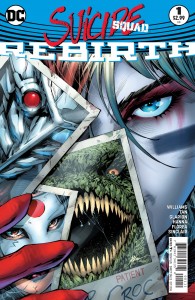 Suicide Squad: Rebirth #1 (of 1) — Writer: Rob Williams; Pencils: Philip Tan; Inks: Jonathan Glapion, Scott Hanna and Sandu Florea; Colors: Alex Sinclair
Suicide Squad: Rebirth #1 (of 1) — Writer: Rob Williams; Pencils: Philip Tan; Inks: Jonathan Glapion, Scott Hanna and Sandu Florea; Colors: Alex Sinclair
Harley Quinn #1 — Writers: Amanda Connor and Jimmy Palmiotti; Art: Chad Hardin; Colors: Alex Sinclair
Justice League #2 — Writer: Brian Hitch; Pencils: Tony S. Daniel; Inks: Sandu Florea; Colors: Tomeo Morey
Nightwing #2 — Writer: Tim Seeley; Art: Javier Fernandez; Colors: Chris Sotomayor
Batman #4 — Writer: Tom King; Pencils: David Finch; 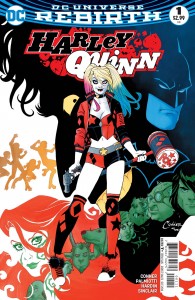 Inks: Sandra Hope and Matt Banning; Colors: Jordie Bellaire
Inks: Sandra Hope and Matt Banning; Colors: Jordie Bellaire
New Suicide Squad and Harley Quinn relaunches during the week the Suicide Squad movie opens — what are the odds, eh? The SS comic resets the group to be as close to the cinema version as possible, bringing back (or, in this incarnation, introducing) Rick Flagg as the incarcerated super-villains’ handler, with Harley, Deadshot and Boomerang squarely in the spotlight. Tan’s art delivers just the dark-edged, gaudy and violent action readers would expeect, and Williams’ script presses all the right buttons, so, like Marvel’s Doctor Strange, this comic should attract both new and old readers. Harley Quinn, while a relaunch, is just more of the same, with creative team Connor, Palmiotti and Hardin all returning, and the 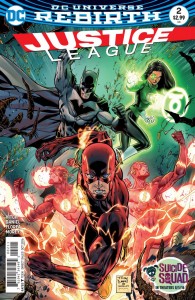 continuity from the previous volume (including Harley’s relationship with the Deadpool parody “Red Tool”) motoring along just as merrily as before; since this book has been one of DC’s top sellers for a couple of years, there was clearly no reason to change anything, and the book’s snarky, cynical, violent yet somehow charming attitude should make it just as popular, and as big a cash cow, as ever. Justice League continues to do its job as a showcase for its all-star character lineup, with the requisite Great Big Threat giving everyone — in this issue, especially the Green Lanterns, Flash, Aquaman and Batman — a chance to engage in all the regular superhero poses and action shots. Daniel’s a classic, right-down-the-middle superhero artist, so it all looks fine, although Hitch’s writing, which has a solid framework, is otherwise very basic; older fans may be disappointed that there’s not
continuity from the previous volume (including Harley’s relationship with the Deadpool parody “Red Tool”) motoring along just as merrily as before; since this book has been one of DC’s top sellers for a couple of years, there was clearly no reason to change anything, and the book’s snarky, cynical, violent yet somehow charming attitude should make it just as popular, and as big a cash cow, as ever. Justice League continues to do its job as a showcase for its all-star character lineup, with the requisite Great Big Threat giving everyone — in this issue, especially the Green Lanterns, Flash, Aquaman and Batman — a chance to engage in all the regular superhero poses and action shots. Daniel’s a classic, right-down-the-middle superhero artist, so it all looks fine, although Hitch’s writing, which has a solid framework, is otherwise very basic; older fans may be disappointed that there’s not 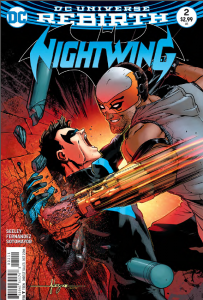 much subtext or depth to it. Nightwing continues its twisty double-double-agent plot, as Dick is simultaneously working for the Parliament of Owls (who think they’re blackmailing him), and the good guys, and partnering with another Owl employee who has his own shadowy agenda. Seeley, as he proved in Grayson, has a knack for this kind of international-spy action thriller, and this is another DC relaunch whose previous fans should be happy with it, while the main character’s return to his costumed identity may bring in some new readers too. That leaves Batman, the best-selling of the previous New-52 books; writer King has been doing a good job here following in the large footsteps of previous scripter Scott Snyder, with the introduction of a couple of new super-heroes to Gotham and a keen insight into the qualities of Batman’s character — the
much subtext or depth to it. Nightwing continues its twisty double-double-agent plot, as Dick is simultaneously working for the Parliament of Owls (who think they’re blackmailing him), and the good guys, and partnering with another Owl employee who has his own shadowy agenda. Seeley, as he proved in Grayson, has a knack for this kind of international-spy action thriller, and this is another DC relaunch whose previous fans should be happy with it, while the main character’s return to his costumed identity may bring in some new readers too. That leaves Batman, the best-selling of the previous New-52 books; writer King has been doing a good job here following in the large footsteps of previous scripter Scott Snyder, with the introduction of a couple of new super-heroes to Gotham and a keen insight into the qualities of Batman’s character — the  preparation, the huge skill set, the quick thinking and the colorful support team — that make his stories so fun to read. As with Snyder, King has a knack for the horror that’s always lurking around every corner in Gotham, and so it’s no surprise that the “new” heroes here end up getting ambushed by a couple of bad guys, and see everything go spectacularly wrong. Finch’s art sometimes reminds me of ’70s Bat-artist (and Phoenix native) Don Newton; it’s basic but solid, and has a shadowy undercurrent that’s well-suited to the city and its many extreme residents, both super-good and super-bad; when combined with a skilled writer like King, it delivers an enjoyable, and suspenseful, reading experience.
preparation, the huge skill set, the quick thinking and the colorful support team — that make his stories so fun to read. As with Snyder, King has a knack for the horror that’s always lurking around every corner in Gotham, and so it’s no surprise that the “new” heroes here end up getting ambushed by a couple of bad guys, and see everything go spectacularly wrong. Finch’s art sometimes reminds me of ’70s Bat-artist (and Phoenix native) Don Newton; it’s basic but solid, and has a shadowy undercurrent that’s well-suited to the city and its many extreme residents, both super-good and super-bad; when combined with a skilled writer like King, it delivers an enjoyable, and suspenseful, reading experience.
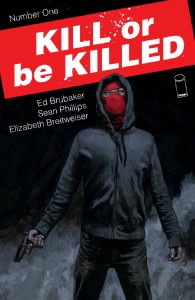 Kill or be Killed #1 — Writer: Ed Brubaker; Art: Sean Phillips; Colors: Elizabeth Breitweiser
Kill or be Killed #1 — Writer: Ed Brubaker; Art: Sean Phillips; Colors: Elizabeth Breitweiser
Animosity #1 — Writer: Marguerite Bennett; Art: Rafael de Latorre; Colors: Rob Schwager
Lady Killer #1 — Writer/Artist: Joelle Jones; Colors: Michelle Madsen
Three new first issues from indy publishers, although two of them are new variations on older properties. Kill or be Killed, for example, is a stand-alone serial that’s part of Brubaker and Phillips’s Criminal imprint, this one about a twenty-something who’s drifting through life and ends up  trying to kill himself, only to survive due to what may or may not be supernatural intervention (from the bad guys, not the good ones), and then becomes a vigilante. This creative team has been working together for over a decade now, and they provide a very smooth, professional ride; if you have any liking for noirish crime/suspense books, get in on the ground floor of this one. Animosity has one of those apocalyptic-animal-revenge plots, where suddenly, and without explanation, all the world’s fauna, from hippos to horses to hamsters, get intelligence and are able to talk — and act out their grievances with the human race. However, instead of focusing on the big picture, it follows a preteen girl in New York City and her loyal dog, who becomes her protector as
trying to kill himself, only to survive due to what may or may not be supernatural intervention (from the bad guys, not the good ones), and then becomes a vigilante. This creative team has been working together for over a decade now, and they provide a very smooth, professional ride; if you have any liking for noirish crime/suspense books, get in on the ground floor of this one. Animosity has one of those apocalyptic-animal-revenge plots, where suddenly, and without explanation, all the world’s fauna, from hippos to horses to hamsters, get intelligence and are able to talk — and act out their grievances with the human race. However, instead of focusing on the big picture, it follows a preteen girl in New York City and her loyal dog, who becomes her protector as 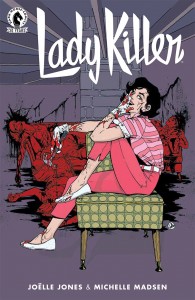 they try to survive. Not bad, with enough tongue-in-cheek, and clever, animal reactions to keep all the death and destruction from being too grim. Lady Killer is a sequel to last year’s mini-series of the same name, about an early-’60s housewife who’s actually a contract killer; that first serial was popular because of Joelle Jones’s detailed, evocative art, part fashion-magazine poses and part slasher-flick violence, and for the deadpan way the title character went about her murderous business, so the fact that Jones is back, and both writing and drawing this installment, is welcome news; if you didn’t see the first story, pick up this one and give it a try.
they try to survive. Not bad, with enough tongue-in-cheek, and clever, animal reactions to keep all the death and destruction from being too grim. Lady Killer is a sequel to last year’s mini-series of the same name, about an early-’60s housewife who’s actually a contract killer; that first serial was popular because of Joelle Jones’s detailed, evocative art, part fashion-magazine poses and part slasher-flick violence, and for the deadpan way the title character went about her murderous business, so the fact that Jones is back, and both writing and drawing this installment, is welcome news; if you didn’t see the first story, pick up this one and give it a try.
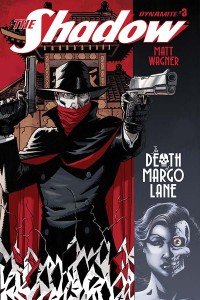 The Shadow: The Death of Margo Lane #3 (of 5) — Writer/Artist: Matt Wagner; Colors: Brennan Wagner
The Shadow: The Death of Margo Lane #3 (of 5) — Writer/Artist: Matt Wagner; Colors: Brennan Wagner
Jughead #8 — Writer: Chip Zdarsky; Art/Colors: Derek Charm
James Bond #8 — Writer: Warren Ellis; Art: Jason Masters; Colors: Guy Major
Trees #14 — Writer: Warren Ellis; Art/Colors: Jason Howard
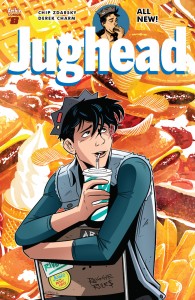 Paper Girls #8 — Writer: Brian K. Vaughan; Art: Cliff Chiang; Colors: Matt Wilson
Paper Girls #8 — Writer: Brian K. Vaughan; Art: Cliff Chiang; Colors: Matt Wilson
Stray Bullets: Sunshine and Roses #17 — Creator: David Lapham
Cinema Purgatorio #4 — Creators: Various
Of the already-ongoing series, The Shadow: The Death of Margo Lane has Matt Wagner both writing and drawing the legacy caped crimefighter, and a plot exactly as its title suggests (Lane may or may not have died in an explosion in 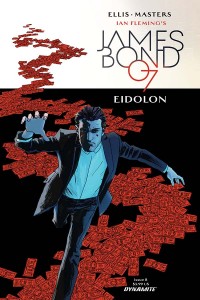 the previous issue, but The Shadow is acting like she did). Wagner is skillful and knowledgeable about pulp characters and their milieu, and watching him tell the tale of The Shadow fighting both his grief and an Oriental crime queen is good, if bloody, fun. Jughead, about as far away from the grim world of Lamont Cranston as you can get, offers the conclusion of a three-parter about Jug and Archie going on a camping trip, in a wilderness that’s actually full of other people, from a Reggie Mantle family reunion to a familiar presence from their high school; complications ensue, of course, and Zdarsky, as he’s been doing since this title relaunched, is good at balancing
the previous issue, but The Shadow is acting like she did). Wagner is skillful and knowledgeable about pulp characters and their milieu, and watching him tell the tale of The Shadow fighting both his grief and an Oriental crime queen is good, if bloody, fun. Jughead, about as far away from the grim world of Lamont Cranston as you can get, offers the conclusion of a three-parter about Jug and Archie going on a camping trip, in a wilderness that’s actually full of other people, from a Reggie Mantle family reunion to a familiar presence from their high school; complications ensue, of course, and Zdarsky, as he’s been doing since this title relaunched, is good at balancing 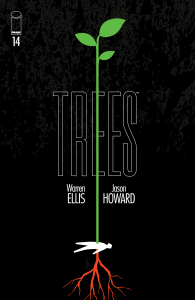 the requisite humor with character development and clever plotting. Fish’s art is a good combination of the cartoony and the (slightly) more realistic; there’s one panel where she has to say volumes with just a silent look, from Jughead to Archie, and she nails it with skill and heart. James Bond and Trees are both written by Warren Ellis, but otherwise very different; Bond, of course, is about that famous British spy, and Ellis, a native of the British Isles himself, takes obvious pleasure in both the bureaucratic battles of the various English espionage agencies, and the more physical contests involving Bond trying to escort a computer-security specialist from Los Angeles to London, while keeping the many forces who want to prevent her from sharing her discoveries from killing her
the requisite humor with character development and clever plotting. Fish’s art is a good combination of the cartoony and the (slightly) more realistic; there’s one panel where she has to say volumes with just a silent look, from Jughead to Archie, and she nails it with skill and heart. James Bond and Trees are both written by Warren Ellis, but otherwise very different; Bond, of course, is about that famous British spy, and Ellis, a native of the British Isles himself, takes obvious pleasure in both the bureaucratic battles of the various English espionage agencies, and the more physical contests involving Bond trying to escort a computer-security specialist from Los Angeles to London, while keeping the many forces who want to prevent her from sharing her discoveries from killing her 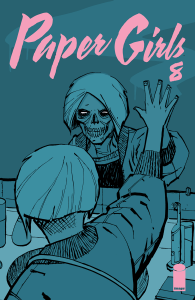 first. Trees continues his long-running (for him) sf series about giant alien constructs that plopped down in key places throughout the globe decades ago, and so far have just been sitting there — but now are beginning to have mysterious, and deadly, effects on the lands around them. Ellis is a visual writer, good both at people and at action set-pieces, and so attracts skilled and detail-oriented artists who are good at the same things; both Masters and Howard are doing some of their best work in these comics. Meanwhile, Paper Girls continuers its tale about its title quartet, growing up in the ’80s in suburbia and getting enmeshed in a time-travel adventure involving kids and adults from the far future, their own adult selves, and a number of other elements, including giant insects and
first. Trees continues his long-running (for him) sf series about giant alien constructs that plopped down in key places throughout the globe decades ago, and so far have just been sitting there — but now are beginning to have mysterious, and deadly, effects on the lands around them. Ellis is a visual writer, good both at people and at action set-pieces, and so attracts skilled and detail-oriented artists who are good at the same things; both Masters and Howard are doing some of their best work in these comics. Meanwhile, Paper Girls continuers its tale about its title quartet, growing up in the ’80s in suburbia and getting enmeshed in a time-travel adventure involving kids and adults from the far future, their own adult selves, and a number of other elements, including giant insects and  iPods; it’s all typically-imaginative and fast-moving Brian K. Vaughan stuff, and Cliff Chiang’s simple-but-expressive style and clear composition help to keep the many characters (and their various past and future versions) clear, while also making the two or three splash-page shocks that Vaughan supplies in every issue just as startling and cinematic as they’re meant to be. In Stray Bullets, David Lapham takes a break from his ongoing crime/noir/caper plot and characters for a stand-alone story of two flawed, frustrated suburban housewives who become friends; if you’re in the market for a great slice-of-life noir comic with a decades-long backlist to dive into, it makes a perfect sampler issue. Finally, Cinema Purgatorio, a serial anthology (like Dark Horse Presents) edited by Alan Moore, features his and Kevin O’Neill’s title feature, about the films shown at a
iPods; it’s all typically-imaginative and fast-moving Brian K. Vaughan stuff, and Cliff Chiang’s simple-but-expressive style and clear composition help to keep the many characters (and their various past and future versions) clear, while also making the two or three splash-page shocks that Vaughan supplies in every issue just as startling and cinematic as they’re meant to be. In Stray Bullets, David Lapham takes a break from his ongoing crime/noir/caper plot and characters for a stand-alone story of two flawed, frustrated suburban housewives who become friends; if you’re in the market for a great slice-of-life noir comic with a decades-long backlist to dive into, it makes a perfect sampler issue. Finally, Cinema Purgatorio, a serial anthology (like Dark Horse Presents) edited by Alan Moore, features his and Kevin O’Neill’s title feature, about the films shown at a 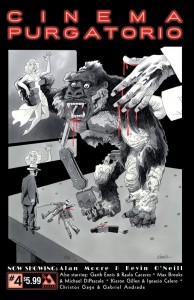 threadbare and ominous movie theater in the afterlife. There’s also ten pages of Garth Ennis and Raulo Caceres’s Code Pru, about an EMT working the night shift who encounters all manner of vampires, werewolves, mummies and other movie-monster characters; Modded, Kieron Gillen and Ignacio Calero’s serial about a demon invasion fought Pokemon-style; Max Brooks and Michael DiPascale’s A More Perfect Union, set in the 1860s and about the two sides of the US Civil War uniting to face an invasion of giant-ant aliens; and The Vast, another humanity-battling-giant-monster B-movie series. The black-and-white art suits the shadowy settings, and there’s more than enough here to justify the $5.99 price.
threadbare and ominous movie theater in the afterlife. There’s also ten pages of Garth Ennis and Raulo Caceres’s Code Pru, about an EMT working the night shift who encounters all manner of vampires, werewolves, mummies and other movie-monster characters; Modded, Kieron Gillen and Ignacio Calero’s serial about a demon invasion fought Pokemon-style; Max Brooks and Michael DiPascale’s A More Perfect Union, set in the 1860s and about the two sides of the US Civil War uniting to face an invasion of giant-ant aliens; and The Vast, another humanity-battling-giant-monster B-movie series. The black-and-white art suits the shadowy settings, and there’s more than enough here to justify the $5.99 price.



